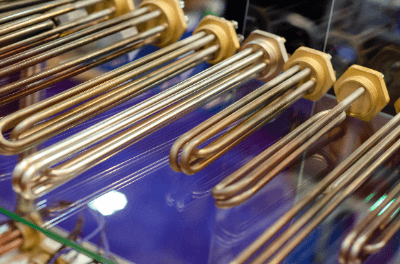What Is a Heater?
 A heater is a general term for any device that generates heat.
A heater is a general term for any device that generates heat.
The type that generates radiant heat by burning fuel is inexpensive and is widely used in home appliances. They are also indispensable devices for processing and assembly in industry.
Uses of Heaters
Heaters are used in a wide range of applications, from household appliances to industry. The following are examples of heater applications.
1. Heaters for Panels
In cold regions with sub-zero temperatures, the internal parts of control panels often experience dew condensation or freezing. Heaters for control panels may be used to maintain a constant internal temperature. Space heaters are also synonymous and are often installed inside generators and other equipment.
2. Piping Heaters
These heaters are used to prevent freezing of water pipes, etc. They are also called anti-freeze heaters, anti-freeze belts, or trace heaters. Tape heaters and belt heaters are mainly used.
3. Industrial Heaters
These heaters are used to heat raw materials and products for industrial purposes. The principles used vary, and non-contact heaters such as induction heating and dielectric heating are also used.
Applications vary and include bearing heaters for bearing mounting and dismounting of rotating equipment. Extruders and molding machines use cast-in heaters, for example.
4. Household Heaters
These heaters are used in homes for heating and other purposes. Typical examples are air conditioners and fan heaters. Ceramic heaters are sometimes used. Microwave ovens and toasters used for cooking are also heaters.
Principles of Heaters
Heaters heat objects according to various principles.
The following are examples of the heating principles of heaters:
1. Resistance Heating
Resistance heating is a method of generating Joule heat by passing an electric current through a resistance. Nichrome wire is used as the heating element. The heating element is placed in a metal sheath, such as a pipe, and the space between the sheath and the pipe is often filled with an insulator.
2. Induction Heating
Induction heating is a method of heating an object by generating and changing magnetic flux with a coil, thereby generating eddy currents. Typical applications include induction heaters for cooking. Although non-contact heating is possible, the object to be heated is mainly a conductive material.
3. Dielectric Heating
This is a method of heating by applying a high-frequency voltage, which shakes molecules and generates frictional heat. Microwave ovens are an example of dielectric heating. It is a non-contact heating method used to heat non-conductive materials.
4. Heat Pump
A heat pump heats by exchanging heat with a heat source and typical examples are air conditioners and water heaters. Air conditioners, for example, add heat to a room by heating the indoor heat exchanger with condensation heat from a compressed refrigerant.
Types of Heaters
There are various types of heaters, classified by the cause of heat generation and application. They are also classified by the method of heat conduction. Heating methods based on resistance heating include convection, conduction, and radiation.
1. Convection Heaters
This method directly heats the air and convects it. There are some disadvantages, such as dryness and dust caused by the warm air. However, it is characterized by the fact that it warms up quickly. Oil fan heaters and ceramic fan heaters are available.
2. Conduction Heaters
This is a method in which heat is transferred by direct contact. Only the part in contact can be warmed. It is characterized by lower power consumption than the convection method. Hot carpets and electric blankets are examples.
3. Radiant Heaters
This method heats by emitting infrared rays and heat, which are electromagnetic waves. It is characterized by a warmth that comes from the air and is quiet. Carbon heaters and oil heaters are available.
Other Information on Heaters
Energy-Saving Technology for Heaters
Effective use of heaters by reducing their energy consumption leads to energy savings. Generally, energy-saving techniques are used by using heat shielding sheets and insulation materials to keep heat outside. In some cases, temperature control by means of voltage control, etc., contributes to energy conservation.
Advanced temperature control also contributes to improved working environments and product processing accuracy. When the heating target is a liquid, such as water or oil, temperature control is required according to the characteristics of the liquid and the target temperature. When heating solids, temperature control is an important factor in quality.